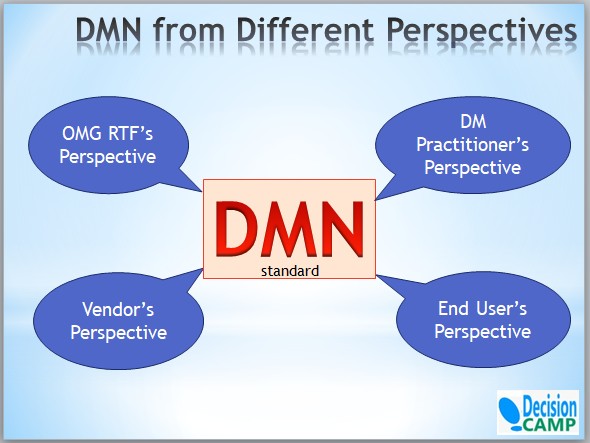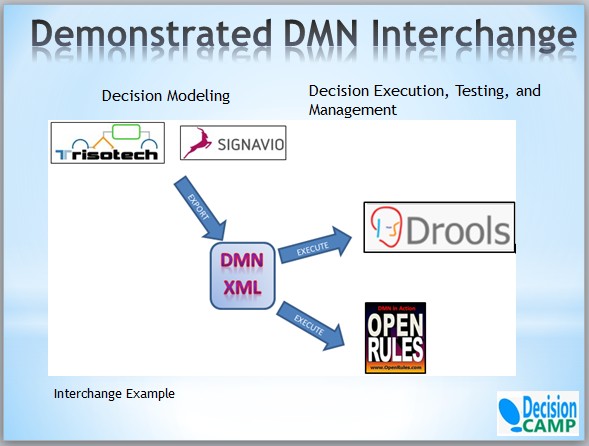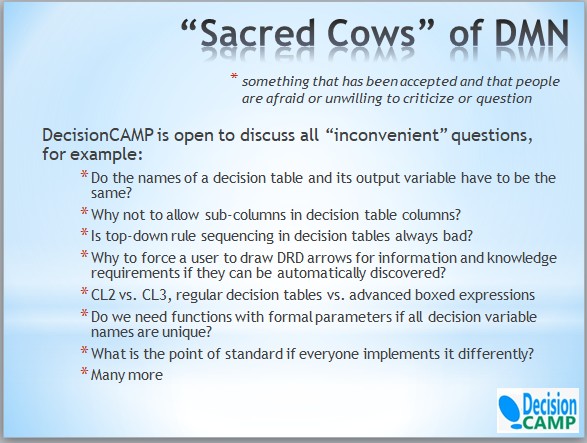 According to many people who attended DecisionCAMP on July 12-14 in London, it became a real success. Let me start with a few quotes from attendees:
According to many people who attended DecisionCAMP on July 12-14 in London, it became a real success. Let me start with a few quotes from attendees:
“Congrats on a very good Decision Camp event. This was a great stimulating event and I look forward to participate to future meetings. It was just great!”
“I would like to express our appreciation for the excellent organization of DecisionCAMP 2017. You may know that the mission of the BBC (British Broadcasting Corporation) is to enrich people’s lives with programmes and services that Inform, Educate and Entertain. We believe that DecisionCAMP, in its first visit to London, admirably achieved all three objectives. The partnering opportunities which arose for us last week will help us to contribute more comprehensively to the DMN/Decision Management community and end users.”
When last year, after successful DecisionCAMP-2016 in New York, we decided to hold the next event outside of the US for the very first time, I worried about potential attendance. Will US specialists show up? However, thanks to the serious event preparation work and a great response from the Decision Management Community worldwide, the actual attendance of DecisionCAMP-2017 proved the London’s location was a good choice. We received 56 official registrations from US, UK, Canada, Germany, New Zealand, Belgium, Italy, Netherlands, France, Spain, Ireland, and Montenegro. We even needed to switch to a larger auditorium at the Birkbeck University to comfortably fit all attendees. Additionally, people from the co-located RuleML+RR conference and students attended our sessions as well.
But it is not a quantity but the quality of our attendees that really made the difference. World-renowned experts including architects from the major vendors, authors of DMN related books, well-known practitioners and bloggers attended the London ‘s camp. We had many members of the DMN Committee who hold their meeting on July 12 as a part of the DecisionCAMP and invited other attendees to attend it. I also received emails from other experts who wanted to attend it but could not make it by personal reasons.
Now about the event content. Here is the list of presenters with their pictures and brief biographies:
http://2017.ruleml-rr.org/decisioncamp-2017-authors/
Instead of the initially planned 1.5 day, we actually ended up with 3 full days described at this schedule:
http://2017.ruleml-rr.org/decisioncamp-2017/decisioncamp-2017-schedule/
The schedule includes the hyperlinks to the actual presentations. Our schedule allocated enough time for networking and as usual the face-to-face meetings with experts during the breaks frequently were even more important than formal presentations.
Thanks to James Taylor, everyday we had live reports from the DecisionCAMP: you may read them in his blog. You may also find live tweets using the hashtag #DecisionCAMP.
In these notes I will share some information from the important discussions that actually occurred during DecisionCAMP-2017 but were not sufficiently described so far. Having open discussions that did not avoid “tough” questions and generated sometimes controversial answers was one of the most valuable part of the event. So, I will talk about some of them.
Of course, the DMN standard was again in the center of almost all discussions. In my opening remarks, I said that DecisionCAMP will consider DMN from 4 perspectives:
I listed the latest DMN achievements such as DMN 1.1 with executable DMN XML, DMN TCK, and demonstrated DMN interchangeability:
At the same time I quoted a frustrated DM practitioner who wrote a day before the DecisionCAMP: “I hope that somebody grabs the assembled community and drags them out of their cubicles and away from the Fintech blah blah… Get them talking to real brown boots engineers who make/do real stuff. Get dirt under their fingernails and mud on their shoes” (thank you, Fred Simkin). It prompted me to bring attention to some of the “sacred cows” of DMN:
The new features of the upcoming DMN 1.2 were presented by Alan Fish. It is interesting that the controversial decision to avoid using spaces in DMN variable and function names was not met with applause – at least two vendors said their customers “love” to use spaces inside the names of decision variables. While I’d also not allow spaces in decision table or function names, I’d not force our customers to put variable names in apostrophes if they contain spaces. But it seems the DMN RTF already made this decision.
Then Bruce Silver masterfully moderated our first open discussion “What you Like and What you Do Not Like in DMN“. Bruce started with my “inconvenient” questions and to my surprise we quickly agreed on the first one (using different names for decision tables and their output variables) but there were pretty hot arguments around other questions. Here is a photo of comments written by Bruce as the questions were discussed:
Probably the most arguments were around the DMN use of programming constructs such as iteration loops, filters, functions with formal parameters, and other boxed expressions which belong to the highly promoted Compliance Level 3 (CL3). I even made a controversial statement that I still would like to see an example of a decision model that cannot be implemented without CL3 boxed expressions using only traditional decision tables (slightly improved as I previously suggested at the LinkedIn DMN forums). As a compromise, Denis Gagne suggested that DMN should find better and simpler graphical representations for these constructs without removing them from the standard. Bruce summarized this discussion as:
You may find it interesting how these DMN “likes” and “dislikes” were recorded by James Taylor:
Likes:
- Eliciting requirements using decision modeling is more productive, more fun, more rapid than traditional approaches to eliciting requirements.
- The use of explicit requirements helps with impact analysis, traceability at a business level.
- Really brings together an industry across multiple vendors in a positive way – it’s great to have a standard, customers like the idea that vendors are compliant.
- Ability to mix and match analytics, AI, rules, manual decision-making, machine learning, optimization and all other decision-making approaches in a single model.
- FEEL has supporters and has some great features – especially for certain activities like defining decision tables, possible for non-technical users to be very precise.
- Ability for business users to clearly express their problem and share this with others to get agreement, prompt discussion – and to do this at several levels.
Dislikes:
- Perhaps too many details too soon, too much of a focus on the meta model and the internals v what a user can see.
- Sometimes the standard is too precise or limiting – not allowing decision tables and output to have different names, for instance.
- Dislike some of the corner case features because they can get people into trouble.
- Not really any good ways to show which kinds of technology or approach can be used in decision modeling – perhaps some icons.
- FEEL has people who don’t like it too, but this is partly because its new and a change and because it perhaps lacks some of the patterns and capabilities needed. More examples would be good too.
On July 13 we had a QnA Panel “Real-world Business Decision Management: Vendor and Practitioner Perspectives” moderated by James Taylor with the following panelists: Gary Hallmark (Oracle), Alain Neyroud (IBM), Nick Broom (DMN practitioner), Jan Purchase (DMN practitioner), Bob Moore (DMN practitioner), Edson Tirelli (Red Hat), Jacob Feldman (OpenRules). Many questions were raised and discussed. Now, 10 days later, my memory subjectively selects only some of them:
- Does DMN innovate? Many panelists agreed that DMN does not bring serious innovations but rather standardizes well-known best practices as it’s supposed to do
- Is DMN here to stay for a long time? Main answers were: “Yes, but only for the next 5-10 years while the standard is well accepted”
- Should decision monitoring be a part of DMN? Gary Hallmark said “it certainly should”. My answer was “No”: while some vendors (e.g. Sparkling Logic) do a great job with decision execution monitoring, I believe it is more practical to provide an API to allow our users to implement application specific monitoring features that frequently go beyond decision models.
- Some experts predict that people will stop purchasing software in the next 5-10 years. What will they purchase? This tough question was raised by Denis Gagne several times during the Camp, and naturally possible answers were not concrete. I mentioned that our smartest customers sold their software once and then for several years already sell not software updates but rather “knowledge” in a form of quarterly updated rules repositories (for example, rules representing the latest best medical practices). I suspect this is the way to go.
- What is the next “killer” application for Decision Management? I don’t remember hearing any specific answer. I just noticed that we probably should look for an answer at our co-located conference “RuleML+RR” where semantic web people already have created good reasoning tools. If we consider our decision models as “decision ontologies” and apply similar reasoning tools to them, we would not need to force our customers to write specific rules that lead to calculation of insurance premiums or acceptance/rejection of loan applications. Having rules to define all relationships inside our inter-related decision models (ontologies), they (users) would only need to specify the goal (e.g. insurance premium), and then a Decision Reasoner will automatically calculate it for a particular insurance policy.
That’s one more reason why we will continue to work together with our RuleML+RR colleagues by organizing the next joint conference. Unfortunately, I did not have a chance to attend RuleML+RR sessions this year but I heard they were good. Luckily, all attendees of the Joint Conference Dinner at the Royal Society of London listened a very interesting speech given by famous Professor Bob Kowalski about the past and future of “Logic and AI”.
In conclusion, as the chair of DecisionCAMP-2017, I want to express my sincere appreciation to all attendees, presenters, and organizers of this great event. Next year together with RuleML+RR we plan to run DecisionCAMP-2018 in Luxembourg at the end of August or beginning of September of 2018. Stay tuned!





















You must be logged in to post a comment.